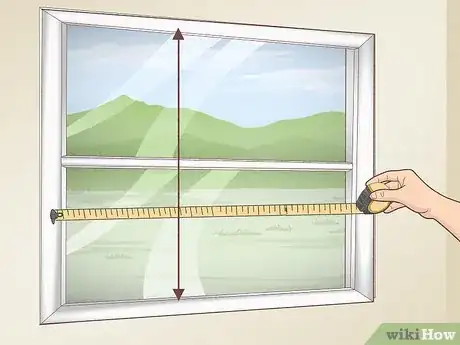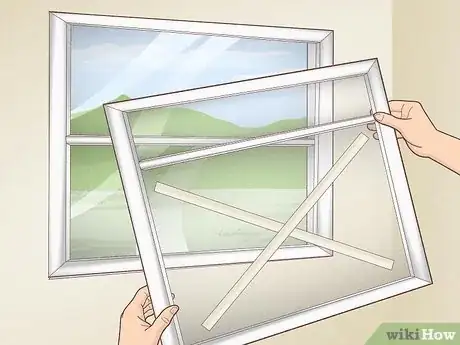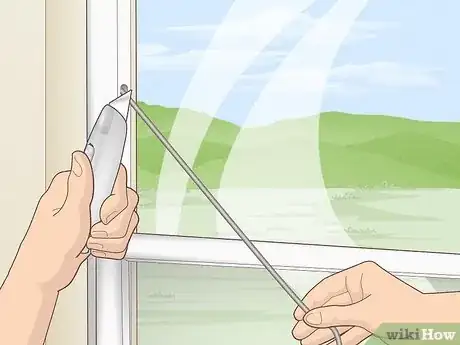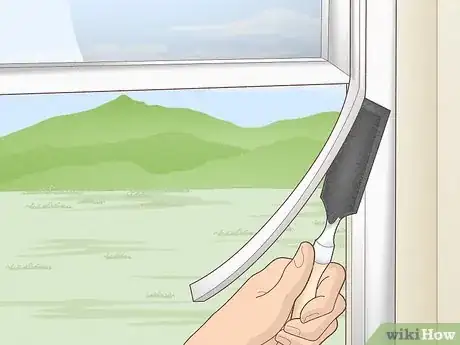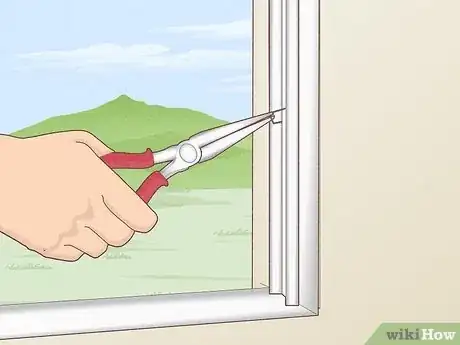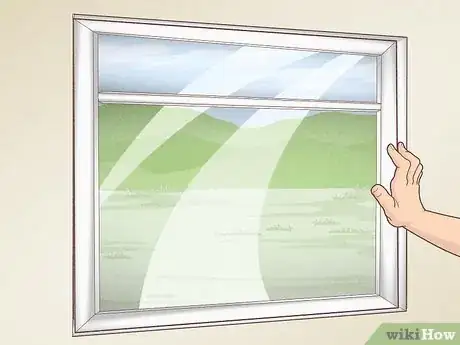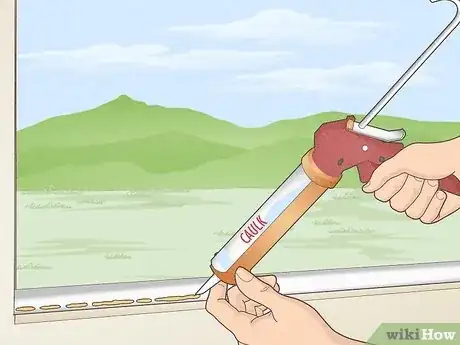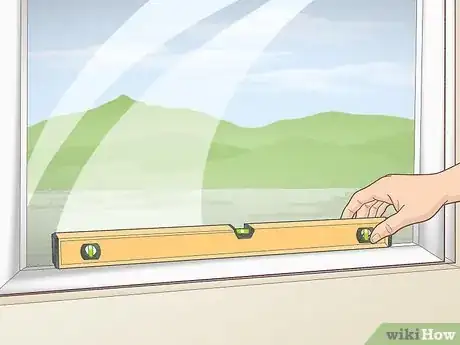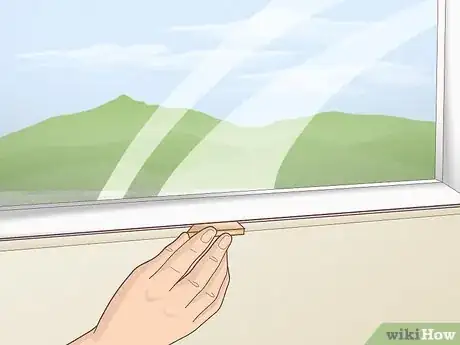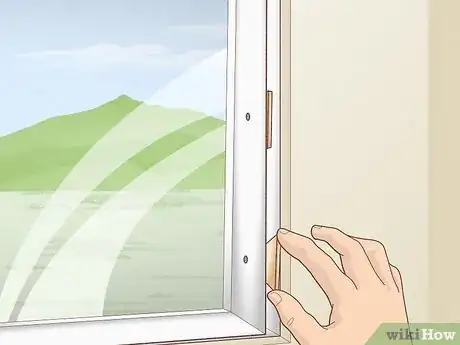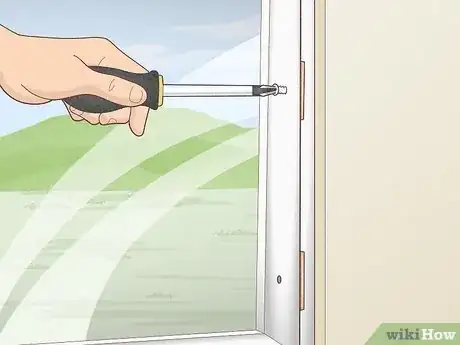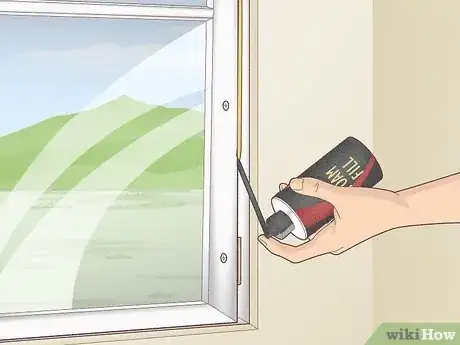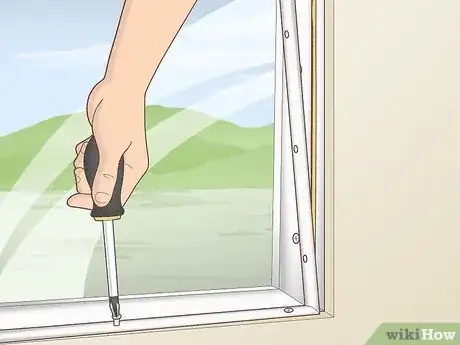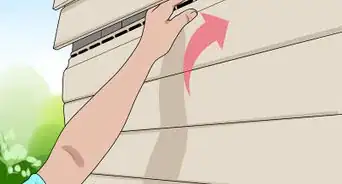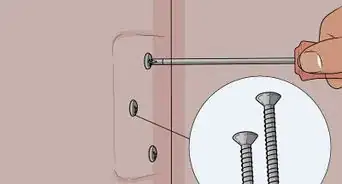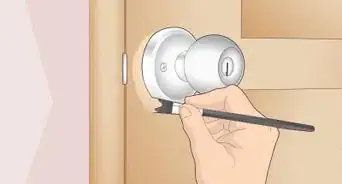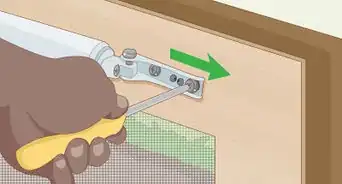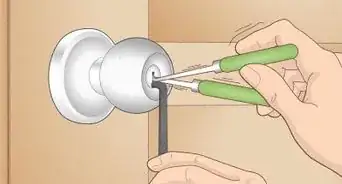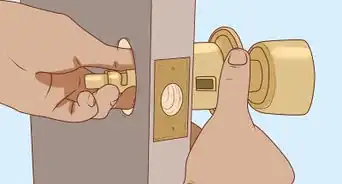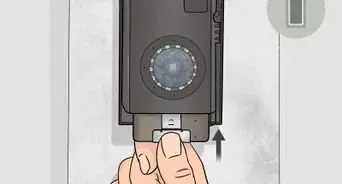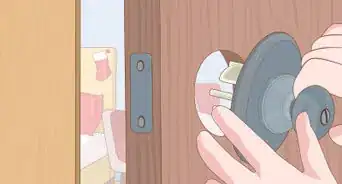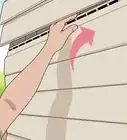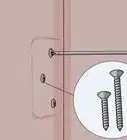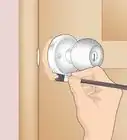This article was co-authored by Michael Fox and by wikiHow staff writer, Caroline Heiderscheit. Michael Fox is a Window Repair Specialist and the President at Window Repair Systems and WindowHardwareDirect.com, based in Westminster, South Carolina. With over 25 years of experience, Michael specializes in commercial window repair and service. He holds a business degree from Monroe Community College and SUNY Brockport. Michael has helped Window Repair Systems and WindowHardwareDirect.com become an industry leader in commercial window repair and hardware distribution, servicing schools and businesses and training large public school systems.
There are 9 references cited in this article, which can be found at the bottom of the page.
This article has been viewed 282,714 times.
Vinyl windows are affordable, easy to install, energy efficient, and a great addition to any home. But how can you install one yourself? You came to the right place! In just an afternoon, you can remove your old window, prep the window opening, and install a new vinyl replacement. Though every window's installation is a little different (and you should follow your window's instructions), we cover the standard process in depth below. For this walkthrough, we'll be installing the window from inside the house. Read on to learn how you can install a gorgeous, vinyl window.
Things You Should Know
- Buy a replacement vinyl window that fits your current window's smallest height and width measurements.
- Carefully save your inside and parting stops as you remove your old window. These can be reused with your new window.
- Install your new window by screwing it into place inside of the window opening. Apply insulation and caulk to ensure your new window is totally secure.
Steps
Removing the Old Window
-
1Measure the width and height of the window opening. Measure the top, the middle, and the bottom of the old window for width.[1] Measure the right side, the left side, and the middle of the old window for height. Measure your window from jamb to jamb. Triple check the measurements to ensure that you purchase the correct size window.[2]
- When purchasing your new vinyl replacement windows, always use the smallest height and width measurements you recorded. Otherwise, your window will be too large.
-
2Purchase a replacement window that fits the hole left by the old window. Replacement vinyl windows will have their dimensions clearly marked on the packaging.[3] Purchase a window at a local home-improvement store, and make sure that it has 2 layers of glass for added insulation. In many cases, your opening will fit a classic replacement window size perfectly, making things simple.
- For a correct fit, the replacement window should be approximately 1⁄4 inch (0.64 cm) narrower than the opening width and height. If your window measurements are in between sizes, round the measurement down.
- If your windows are an unusual size and a corresponding size of replacement window is not in stock at the home-improvement store, ask about custom ordering the vinyl windows.
Advertisement -
3Remove the inside trim, moldings, and stops with a broad chisel. Slip the broad chisel just outside the edge of the currently installed window. Wiggle the chisel back and forth to loosen the paint and caulking between the window frame and the sashing.[4] When one panel loosens up, gently pull it away from the frame.
- Once you’ve removed the trim and molding, don’t throw it away. Save these items for later use.
- In all likelihood, your window will have 3 stops: one at the top, one on the left, and one on the right side of your frame.
- Not all windows have stops. If yours do not, don’t worry. In this case, you only need to remove the trim and moldings.
-
4Remove old cords and weights from the bottom sash if necessary. Weights and balances are used on some older models of aluminum or vinyl windows, but not on most modern windows (quickly scan your window frame, as they'll be noticeable and dangling on the left and right sides). Carefully remove these items from the frame, using a pair of scissors to cut the cords if needed.[5]
- You can throw old weights and cords away, since your new window will come equipped with these items.
-
5Pry out the parting stops at the top and sides of a double sash window. Parting stops keep the sashes separate, but they're only relevant for double sash windows. Using your broad chisel again, pry the parting stops away just like you removed the first set of stops. Once you've pulled the stops out, set them aside. You'll reinstall them once the replacement window is in place.[6]
- Be careful not to jam your chisel into the window frame, since you’ll install the replacement window in the same location.
-
6Remove the top and bottom sashes once the stops are out. The sashes should no longer be held in place against the window frame. Lift out the top sash first by pulling the bottom lip forward and out, away from the lower sash. Remove the bottom sash by pulling its upper lip upwards and outwards, straight towards your body. Set both sashes aside.[7]
- Dispose of the old sashes once you’ve removed them from the wall.
-
7Remove the securing staples that hold the aluminum tracks in place. If the existing window is fitted with aluminum tracks, use a pair of pliers to pull out the staples holding the tracks in place. Once the staples are out, lift out both the window sashes and the aluminum track.
- If the tracks are held in place with screws, remove the screws using a Philips-head screwdriver, then pull out the tracks.
Preparing the Window Opening
-
1Scrape any loose paint or stain off of the window jambs. There may be paint remnants and loose caulk or expanding foam stuck to the window jambs. Run a paint scraper along the interior and exterior surfaces of the window jamb. Keep the scraper at a 30° angle and apply firm pressure to scrape the jambs clean.[8]
-
2Make sure that your replacement window fits in the frame. Close and lock the window sashes on the replacement window. Set the new window in the opening to verify that your earlier measurements were correct and the window fits snugly in the opening.[9] Then, remove the new window from the opening in your wall.
-
3Apply caulk to the inside and outside edges of the stool. The stool is a flat board jutting out from the wall at the bottom of your window. Visit your local hardware store and purchase 1 tube of professional-grade exterior paintable caulk. Run a thin, even bead of caulk along the edges of the stool where it meets the window apron (the vertical board located just below the stool) and the window sill. Also apply caulk to the outside blind-stops and along the top of the opening's header.[10]
- Caulk will keep the stool of the window from being damaged by water drops. It will also prevent drafts from entering your home.
Positioning the New Window
-
1Set the replacement window into the frame opening. Set the bottom of the window in first and lift the rest of the window up into place. To secure the window, butt the exterior window frame up against the opening blind stops. Do this from the interior wall side, and take care not to push the window clear out the other side of the wall.[11]
- Make sure that the sashes are still locked when you set the window in place.
-
2Use a level tool to ensure that the window is level. The replacement window may not sit flat in the window hole once you’ve set it in place. To determine if it’s level, set a level on the top of the lower sash and look to see if the indicator bubble floats to the center of the tube. Even if the window looks level, it may be off-kilter to a very slight degree.[12]
- If you don’t have a level, purchase one at a local hardware store. The tool resembles a metal bar that’s roughly 18 inches (46 cm) long.
-
3Insert shims beneath the window until it sits flat and opens smoothly. Shims are nearly flat pieces of wood that slightly raise the level of one side of the window. If the installed window doesn’t cleanly open and close or if it’s not level, place 1 shim at a time beneath the low side to raise it up. To secure the frame, place shims at the middle of the frame and at the middle of the top and bottom sashes as well (until you get a level read).[13]
- Once the shims are in place and the window is square and opens and closes smoothly, snap off the shim stems.
-
4Install shims behind screw holes. This will prevent the frame from becoming warped when you tighten the screws through the window and into the frame. Place shims directly behind the jamb where each screw will be inserted. When you insert the screws, they’ll pass directly through the shims.[14]
- If the ends of the shims stick out once you’ve screwed the window into place, snap them off.
Securing the Window in Place
-
1Use screws to secure the window to the opening in your wall. Most replacement vinyl windows are screwed in place. Take your replacement screws and install them through the screw holes in the window sashing. Align the screws with the pre-existing holes in the wooden window frame. Tighten the screws with a screwdriver until they’re firmly in place.[15]
- The replacement window should have come with screws for installation when you purchased it. So, you won’t need to purchase these screws separately.
-
2Install insulation around the window between the frame and opening. Use low-pressure expanding foam made from polyurethane. Shake the can and attach the narrow tube as directed. Stick the point of the tube in the gaps around your installed window, and squeeze the trigger until the gap is filled with foam. Be careful if you’re using traditional expanding foam for the insulation, as installing too much insulation on top and bottom may cause window to bow.[16]
- Insulation will block drafts and keep the window from letting hot or cold air you’re your home.
-
3Reinstall the stops, trim, and molding that you removed earlier. Depending on the style of replacement vinyl windows that you purchased, these items may need to be screwed into place, or they may be held in place by pressure. If they need to be screwed in place, the screws will be included in the replacement window packaging.[17]
- Work gently with the stops, since they’re relatively delicate and can break easily.
- If you do accidentally snap a stop, don't stress. Find the right stop by bringing your window's measurements to a home improvement store.
Expert Q&A
-
QuestionHow do you fix a broken balance on a vinyl window?
 Michael FoxMichael Fox is a Window Repair Specialist and the President at Window Repair Systems and WindowHardwareDirect.com, based in Westminster, South Carolina. With over 25 years of experience, Michael specializes in commercial window repair and service. He holds a business degree from Monroe Community College and SUNY Brockport. Michael has helped Window Repair Systems and WindowHardwareDirect.com become an industry leader in commercial window repair and hardware distribution, servicing schools and businesses and training large public school systems.
Michael FoxMichael Fox is a Window Repair Specialist and the President at Window Repair Systems and WindowHardwareDirect.com, based in Westminster, South Carolina. With over 25 years of experience, Michael specializes in commercial window repair and service. He holds a business degree from Monroe Community College and SUNY Brockport. Michael has helped Window Repair Systems and WindowHardwareDirect.com become an industry leader in commercial window repair and hardware distribution, servicing schools and businesses and training large public school systems.
Window Repair Specialist Balances wear out over time. Look at the balance itself and get the number that's stamped on it. Then, reorder balances from that stamp. If it's a spiral balance, you need to take it out and measure that. Then, you'll need to measure and weigh the sash so you can get the length and weight for the window. Once you have that, just replace the balances and your window will work like new.
Balances wear out over time. Look at the balance itself and get the number that's stamped on it. Then, reorder balances from that stamp. If it's a spiral balance, you need to take it out and measure that. Then, you'll need to measure and weigh the sash so you can get the length and weight for the window. Once you have that, just replace the balances and your window will work like new. -
QuestionHow long does it take to install an average window?
 Community AnswerDepending on size, it could take anywhere from 10 to 30 minutes. It also depends on how good the framing is - it it's bad, it will take longer.
Community AnswerDepending on size, it could take anywhere from 10 to 30 minutes. It also depends on how good the framing is - it it's bad, it will take longer. -
QuestionWhat is the average replacement time for a window?
 Community AnswerIf you are replacing an existing window, allow yourself about an hour to remove the old window and prep the RO (rough opening) for installation of a new window. Allow another 30 to 45 minutes to insulate and caulk the new window.
Community AnswerIf you are replacing an existing window, allow yourself about an hour to remove the old window and prep the RO (rough opening) for installation of a new window. Allow another 30 to 45 minutes to insulate and caulk the new window.
Warnings
- Always wear safety goggles, gloves, and a face mask during removal and installation of windows. Without these protective items, you could inhale sawdust or get a serious splinter in your hand or eye.⧼thumbs_response⧽
- If you're working with a house built before 1978, your paint might contain led. In this case, call a professional for assistance.⧼thumbs_response⧽
Things You'll Need
- Tape measure
- Broad wood chisel
- Phillips-head screwdriver
- Pliers
- Level
- Safety glasses
- Caulk gun
- Professional grade exterior paintable caulk
- Drill
- Paint scraper
- Expanding foam insulation
References
- ↑ Michael Fox. Window Repair Specialist. Expert Interview. 1 December 2020.
- ↑ https://youtu.be/ER1ZeFu2C-8?t=163
- ↑ Michael Fox. Window Repair Specialist. Expert Interview. 1 December 2020.
- ↑ https://www.todayshomeowner.com/video/how-to-replace-aluminum-windows-with-vinyl-windows-on-your-home/
- ↑ https://youtu.be/ER1ZeFu2C-8?t=225
- ↑ https://youtu.be/o0HODrbpBG4?t=92
- ↑ https://youtu.be/o0HODrbpBG4?t=101
- ↑ https://www.todayshomeowner.com/video/how-to-replace-aluminum-windows-with-vinyl-windows-on-your-home/
- ↑ Michael Fox. Window Repair Specialist. Expert Interview. 1 December 2020.
- ↑ https://todayshomeowner.com/video/how-to-replace-aluminum-windows-with-vinyl-windows-on-your-home/
- ↑ https://todayshomeowner.com/video/how-to-replace-aluminum-windows-with-vinyl-windows-on-your-home/
- ↑ https://www.todayshomeowner.com/video/how-to-replace-aluminum-windows-with-vinyl-windows-on-your-home/
- ↑ https://todayshomeowner.com/video/how-to-replace-aluminum-windows-with-vinyl-windows-on-your-home/
- ↑ https://todayshomeowner.com/video/how-to-replace-aluminum-windows-with-vinyl-windows-on-your-home/
- ↑ https://www.todayshomeowner.com/video/how-to-replace-aluminum-windows-with-vinyl-windows-on-your-home/
- ↑ https://youtu.be/ER1ZeFu2C-8?t=980
- ↑ https://youtu.be/o0HODrbpBG4?t=182
About This Article
Installing a vinyl replacement window is relatively straightforward, and you can do it in an afternoon provided you have the right tools. To start, you’ll need to remove the old window by removing the inside trim, moldings, and stops with a broad chisel. Then, pry out the parting stops at the tops and sides of the window, and remove the top and bottom panes. You should also use pliers to remove the securing stapes holding the aluminum tracks in place. Before you install the new window, scrape off any loose paint, stain, or caulk with a paint scraper so the window goes in smoothly. Then, apply a thin, even line of caulk to the inside and outside edges of the stool. Set the new window into the frame, putting the bottom in first and lifting the rest of the window up into place. To secure the window, screw it into the wall, then add insulation around the frame and opening. To learn how to fix a window that’s not opening smoothly, read on!
